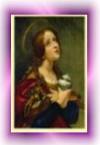Jan 2,2002
Christ as Lion and Lamb
"The Other Side of Christ"
by Fr.Robert D.Smith
(deceased Dec.,2001)
Father Robert Persons(1546-1610), of the Society of Jesus, made an
observation that was surprising in his own time, and is no less surprising four
hundred years later. He noted that St.John the Evangelist "affirmed that (Christ
Who) was slain as a Lamb, should come again to judge as a Lion."
Father Persons was referring to a passage in St.John's Apocalypse that
describes the day of judgment and speaks of Christ, the Lamb of God, as
appearing on that day as the Lion of the tribe of Judah, the only one worthy to
open the scroll of the revelation of judgment. The judgment described later on
in the opening of the seals completely fits the imagery of Lion as Judge: sur-
prising grace and clemency on those the Lion considers loyal friends; sur-
prising wrath on those He does not. The seven seals of the scroll, when opened,
are all in terms of fear.
At the opening of the first four seals on judgment day, one of four living
creatures (Rev.6:1) cries out, "Come forward." and fearsome riders come
forth to wreak havoc and measure judgment. The fifth seal, which reveals the
spirits of the martyrs, the saved, does so in terms of vengeance (Rev.6:10). The
opening of the sixth and seventh seals brings cataclysm."There was a violent
earthquake....The stars in the sky fell crashing to earth like figs shaken
loose by a mighty wind. The sky disappeared as if it were a scroll being
rolled up; every mountain and island was uprooted from its base. The
kings of the earth, the nobles and those in command, the wealthy and
powerful, the slave and the free-all hid themselves in caves and mountain
crags. They cried out to the mountains and rocks, 'Fall on us! Hide us from
the face of the One who sits on the throne and from the wrath of the Lamb!
The great day of their vengeance has come. Who can withstand it?' ''
(Rev.6:12-17)
A Lion is, if anything, a mild symbol for the imagery involved here. And
the Lamb is somehow also a Lion.
The idea of Christ as the Lamb of God has been very much misunder-
stood in our time. Many people tend to think that Christ can be described as a
Lamb in every way possible-nonaggressive, always patient. Christ came, how-
ever, as the Pharisees knew all too well, speaking with authority, dogmatically.
He delivered His teachings as true, as the Word of God, not with hesitations
and doubts, as the Pharisees taught their followers. From the point of view of
speech, as from a Lion or a Lamb, it was the Pharisees who were lambs, and
Christ the Lion. It was the Pharisees who were bleating, not Christ.
He came revealing many things. Among His revelations was that of the
existence of heaven and hell, two places effectively unmentioned in the Old
Testament. He said that heaven was only for those who repented and believed;
hell was for everyone else. And He repeated this many times and in many ways.
This message is, in a sense, more that of a Lion than that of a Lamb.
He spoke of hell more often than He did of heaven. When He spoke of
both heaven and hell, He almost invariably, although the world ignores it,
stressed the punishment more than the reward. The classic instance of this is
with the Beatitudes and the Woes. If we see a movie about the life of Christ
(and very often such movies are put out under the auspices of unbelievers),
Christ will almost inevitably be shown delivering the Beatitudes, but never the
Woes. Yet when we read the Gospels, we see that He spent triple the time on
the Woes (Matt.13:13-36) as He did on the Beatitudes (Matt.5:3-12). This ratio
is even higher in St.Luke's Gospel.
How then is Christ a Lamb? He taught this strong religion in terms of
nonaggression in this world. Force is never to be used to spread it. He himself
never used force from His followers or from the angels (Matt.26:53). Above all,
and this was readily understandable in Judaism at the time, He came as an un-
blemished Lamb, as a parallel to the unblemished lamb in the Jewish Passover,
sacrificed and eaten without breaking its bones. He allowed himself to be put to death as a Lamb, without a fight or even a word.
And He calls His followers to this same course of religion nonaggression
in this world. But not because there is no element of the Lion in Himself or in
His religion-particularly on judgment day.
"Well done, good and faithful servant"
Matt.25:21
Christ as Lion and Lamb
Christ as Lion and Lamb
Devotion to the souls in Purgatory contains in itself all the works of mercy, which supernaturalized by a spirit of faith, should merit us Heaven. de Sales
